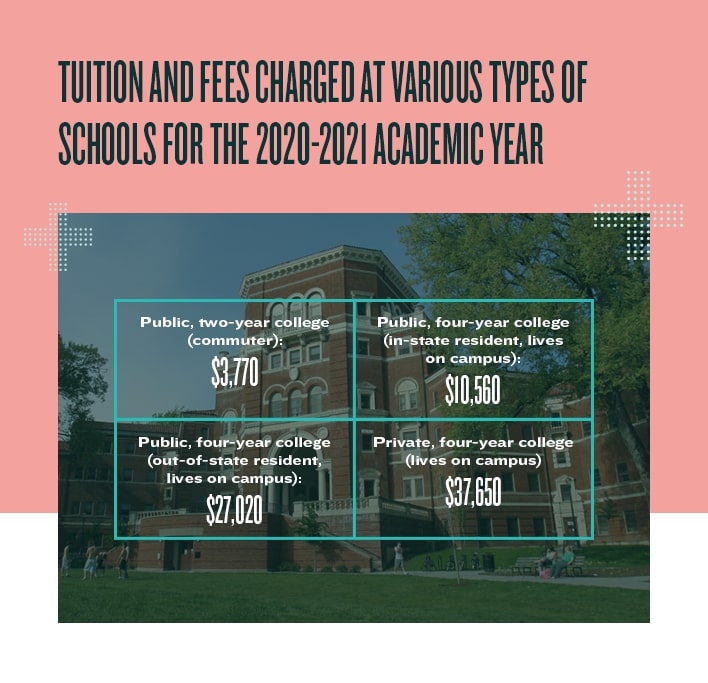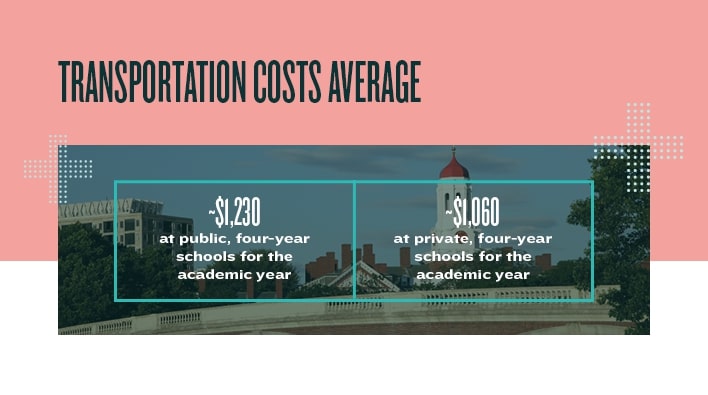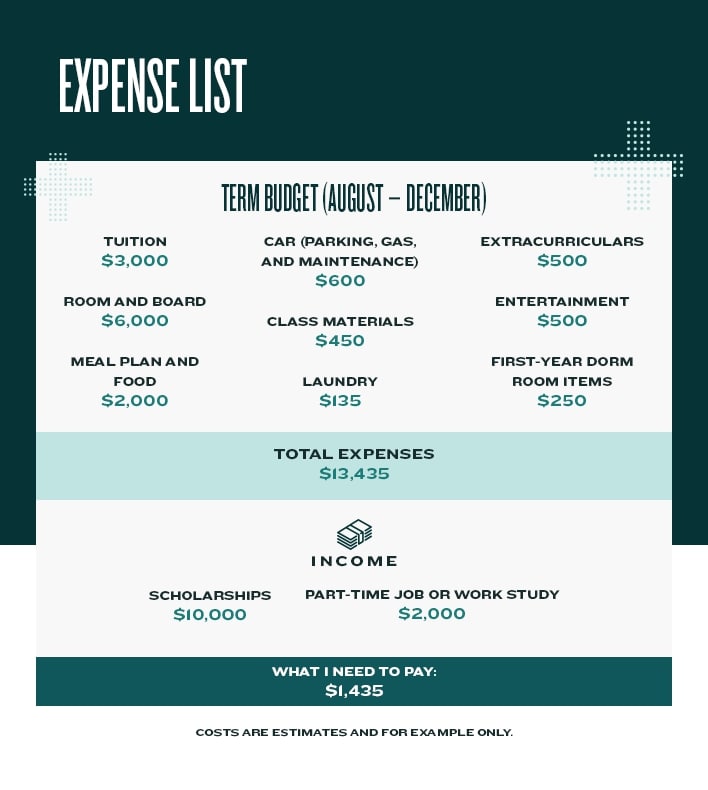Updated on June 29, 2021
Heading off to college is a momentous time in a student’s life. In many instances, moving into a dorm room or apartment marks the first time that a person has lived on their own. Freshman year is often full of other important firsts as well, such as a student’s first time managing finances on their own.
Some first-year students haven’t had to truly think about budgeting in the past. Even college students who have financial support might find that they need to take a closer look at their expenses and the cost of going to school to make sure they won’t run out of funds before the end of the term.
How Much Does It Cost to Go to College?
Knowing what expenses students typically encounter can help you prepare for your first year of school and beyond. Here’s a look at some common first-year costs.
1. Tuition
Tuition is often the most significant expense first-year students and others face when it comes to paying for college. Students who live on campus and attend a public four-year school typically devote about 40% of their budget to tuition costs. Meanwhile, students who live off campus and attend a two-year school usually spend about 20% of their budget on tuition and fees.

Tuition costs vary considerably based on the type of program you enroll in and the type of school you attend. Tuition can also vary from year to year, as schools can increase (or decrease) the amount they charge. On average, tuition and fees charged at various types of schools during the 2020-2021 academic year were as follows:
- Public, two-year college (commuter): $3,770
- Public, four-year college (in-state resident, lives on campus): $10,560
- Public, four-year college (out-of-state resident, lives on campus): $27,020
- Private, four-year college (lives on campus): $37,650
Although the amount charged for tuition may seem high, especially for private, four-year colleges, those amounts aren’t typically what the average student ends up paying out of their own pocket. Depending on whether a student qualifies for financial aid or not, and the type of aid they receive, the actual amount a student ends up spending on tuition can be considerably less.
For example, during the 2020-2021 academic year, the cost of undergraduate tuition at Harvard College was $15,143. However, the average annual cost that students pay was just $15,561. Harvard notes that more than half of its students receive aid in the form of scholarships, and that about 20% end up paying nothing for school out of pocket.
2. On-Campus Housing
If a student lives on campus and not at home with their parents during the first year of college, the cost of housing is another considerable expense. The good news about the cost of room and board for on-campus students is that it’s usually considered an educational expense and is often eligible for financial aid.

The cost of room and board varies based on the type of school and where the student lives. The average cost of room and board at a public institution for the 2020-2021 academic year was $11,620. For students attending a private, four-year college or university, the average cost of room and board for the 2020-2021 academic year was $13,120.
3. Books and Supplies
Textbooks and school supplies are another significant expense for many first-year students. In some ways, the cost of supplies can be higher during the first year because you need to purchase items that you’ll use throughout your undergraduate career.
For example, you might need to buy a graphing calculator at the start of your first college term. Provided that the calculator doesn’t break or become outdated over the next few years, you can use it throughout your college career. The same is potentially true of other common first-year purchases, such as a laptop or printer.

When you’re trying to figure out how much you can expect to spend on books and supplies, you’ll get different figures based on where you look. On average, however, students at four-year schools spend around $1,240 per year on books and supplies.
You can cut costs by renting textbooks or purchasing e-books – which are often less expensive than traditional textbooks. Some students find ways to access materials for free, such as borrowing them from the library or by accessing them online. If you choose to acquire your textbooks buy renting or borrowing, be sure you’ll receive any “extras” – like required access codes or additional online content.
4. Meal Plan and Groceries
Some schools require students who live on campus to purchase a meal plan, also known as “board,” which provides a certain number of meals, or a set amount of spending money for use in the school’s cafeterias or dining halls, each week. In some cases, the cost of a meal plan and the cost of the dorm are combined and listed as “room and board.” Other schools may list these as separate expenses.
The cost of a meal plan varies based on how many meals a student expects to eat in the dining halls each week. Some schools offer a range of options, such as a five-meals-a-week plan or an unlimited-meals-per-week plan, while others offer just one plan. Depending on the school and the size of the plan, the cost can be a few hundred dollars to a few thousand dollars per year.
Although some students might be content with only eating in the school’s dining halls or cafeterias, others might want to supplement their meal plans with groceries and snacks. Fortunately, there are ways to save on groceries as a college student, such as using coupons and shopping at bargain grocery stores.
5. Transportation and Parking
Another common expense during a student’s first year of college is transportation. While some schools don’t allow first-year students to have a car on campus, others do, as long as a parking permit is secured. Students who decide to bring their own car to school need to consider the cost of parking it, as well as other costs of vehicle ownership – like gas, car insurance, and maintenance.
Even students who don’t have a car will want to think about the cost of travel. Depending on the school’s location, transportation expenses for car-free students might include transit passes or paying for public transportation options such as the subway or bus. Some schools have agreements with local public transportation systems to allow students to ride for free or at a reduced cost. So, if you’re planning to use public transportation, don’t forget to research available discounts.
Parking and transportation costs average about $1,230 at public, four-year schools for the academic year and about $1,060 at private, four-year schools.

6. Personal Expenses
You’ll want to remember to account for personal expenses – like cleaning supplies or hygiene products – in your overall budget.
Personal expenses can vary widely depending on your needs and preferences. One way to keep your personal expenses low is to get free samples of products when you can and invest in “value-size” or “family-size” products, when available.
Hidden Costs During Your Freshman Year
Although tuition, room, board, and the cost of supplies are usually obvious expenses associated with going off to college, there are a few that many people forget about. When estimating the cost of college, don’t forget about these “hidden” costs.
1. Laundry
Laundry is a cost most first-year students need to account for when putting together their budgets. Depending on how many loads of laundry you need to do each week and how long you can go before washing your clothing and linens, the average cost might be around $6 per week.

2. Visits Home
Odds are you don’t want to spend all your time on campus. There might be occasions when you want to go home, such as around the holidays or for family events. How much it costs you to get home depends in part on how far you live from your school and the transportation methods available to you.
If your home is several states away, your best option might be flying. You can reduce the cost of flights home by booking well in advance, if possible. Choosing a less desirable flight, such as a “red eye” can also help to reduce the cost of travel home.
3. Dorm Room Items
The little things that’ll turn your dorm room into a home away from home don’t come for free, but they tend to be a one-time expense. For example, you might only need to purchase bedding at the start of your freshman year. Depending on their quality, you might be able to use the same sheet sets for the next four years. The same is true for towels, desk lamps, laundry baskets, and decorative items.
4. Extracurricular Activities
Making the most of your time as a college student often comes at a cost. How significant that cost is depends on the activity. For example, students who join a fraternity or sorority during their freshman year usually have to pay membership dues.
The costs vary based on the school and a person’s level of participation in the organization. For example, at the University of Pennsylvania, fees for Greek life range from a program fee of $91 per year, to a fee of up to $1,200 per year for chapter dues. Members also pay fees for rent if they live in the house or a membership fee of up to $550 per semester if they don’t.
Greek life isn’t the only extracurricular activity that comes with a cost. Students might have to pay dues or buy supplies to join and participate in on-campus clubs, sports teams, or marching band.
5. Entertainment
The good news about being in college is that often, many on-campus programs are free. Schools might offer movie screenings and social events at no extra cost to students.
But while many on-campus activities are free, some do charge admission. For example, you might need to purchase tickets to attend a sporting event at your school, especially if your school’s team is doing well. Other entertainment activities that might charge for admission include dances, theater productions, and other events.
6. Additional Class and Testing Fees
Although not the case with every class, a few courses on campus might charge additional fees on top of what you’re paying for tuition. For example, classes that have a lab component often charge a separate lab fee. If you need to take a placement test to determine which level of class is most appropriate for you, your school might charge you for the test.
Financial Aid Can Vary Over Time
One last consideration when making a list of your expected college expenses: Your financial aid package might fluctuate throughout your education, including throughout your first year of school. For example, you might be offered certain types of aid at the start of the year, on the presumption that you’ll remain a full-time student. If you end up switching to a part-time schedule during the first or second semesters of your freshman year, though, you might lose some of your aid, increasing the overall cost of your first year.
Your grades can also affect the aid you receive, potentially raising your out-of-pocket costs. For example, some scholarships are given out with the requirement that you maintain a certain GPA. If your grades drop, you might lose your funding, increasing the cost of school.
How to Make College Less Financially Challenging
The cost of college and college-related expenses can be shocking. It might seem as if there’s no way you’ll ever be able to afford it.

Before you panic about the various expenses associated with getting a degree, take a deep breath. There are things you can do to manage your money in college and pay less out of pocket for your degree.
1. Create a Budget
One of the first things you can do to make college less financially challenging and to give yourself a better understanding of the overall cost of school is make a budget. You can create a monthly or by-term budget, depending on how you expect to cover your expenses while in school. Whichever method you choose, include a list of your potential expenses and the estimated amount of each expense.
You’ll most likely have to estimate costs such as personal care items, clothing, and transportation, at least at first. Choose a tracking method that you’ll stick to – whether that’s an app or a simple spreadsheet – to keep yourself organized. Once school begins and you have a clearer idea of what you’re spending in those categories, you can go back and adjust your budget.
Along with listing your expenses, make a list of your funding or income sources. Do you plan on working while in school, or saving money from jobs over summer or winter break? Be sure to include any sources of financial aid in your budget, provided you know what they are.
2. Apply for Financial Aid
Even if you don’t think you’ll qualify for financial aid, it’s worth applying for it, and it’s worth noting that some schools may require you to complete the FAFSA. The U.S. Department of Education gives out more than $120 billion in financial aid each year, to around 13 million students. States also often have their own financial aid programs, as do many schools. From grants and scholarships to work-study or student loans, it’s likely that there’s a financial aid option out there for you.

3. Apply for Scholarships
In addition to seeking out financial aid from your state or the federal government, as well as financial aid from your school, it can be worthwhile to apply for any scholarships you’re eligible for. You can keep applying for scholarships throughout your college career to keep the cost of school down.
Some schools offer merit-based scholarships to students automatically, based on factors such as GPA and SAT or ACT scores. Private organizations also award scholarships. A few sources of scholarship money worth checking out include:
- Your parents’ employers
- Volunteer organizations
- Churches or religious organizations
- The military
- Private companies or corporations
We also offer scholarships for members who are high school students.
Just remember to be alert of possible scholarship scams. While monetary awards distributed to students by schools and businesses are a great way to pay for education, not all scholarship offers are legitimate.
4. Start Your College Career at a Community College
Along with tracking down all of the sources of financial aid you can, one way to make college costs more manageable is to begin your education at a local community college. The average tuition cost at a public, two-year school was around $3,770 during the 2020-2021 school year. That’s nearly two-thirds less expensive than the cost of tuition at a public, four-year school (for in-state students) and about a tenth the price of tuition at a private, four-year school.
Community colleges often have articulation agreements with four-year schools for students who intend to transfer after completing their two-year program. Research which schools your community college has agreements with and discuss your plans with your academic advisor. Doing so can help you make sure you’re able to transfer as many credits as possible and you aren’t paying for unnecessary courses.
Starting your post-secondary career at a community college or two-year school also saves you money on room and board if you remain at home with your family during that time.
Whether you get started at a two-year college or find a way to make the most of your financial aid options to begin at a four-year institution, a college degree is within reach. If you’re interested in taking out student loans to help pay for school, PSECU can help. Contact us today to learn more about the Smart Option Student Loan® for PSECU by Sallie Mae® and how we can help you ensure your education costs are covered.

The content provided in this publication is for informational purposes only. Nothing stated is to be construed as financial or legal advice. Some products not offered by PSECU. PSECU does not endorse any third parties, including, but not limited to, referenced individuals, companies, organizations, products, blogs, or websites. PSECU does not warrant any advice provided by third parties. PSECU does not guarantee the accuracy or completeness of the information provided by third parties. PSECU recommends that you seek the advice of a qualified financial, tax, legal, or other professional if you have questions.
